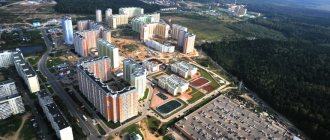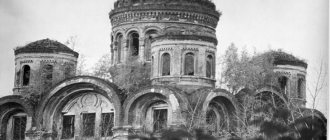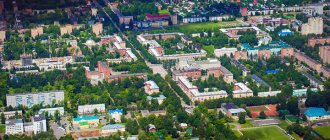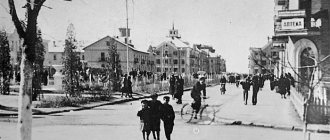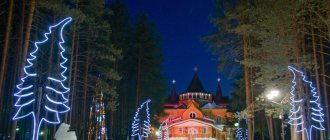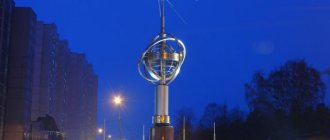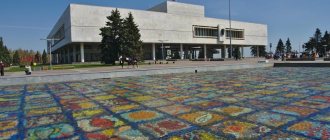The town of Stupino, located in the Moscow region, attracts tourists with a large number of attractions. Its history began with a small village founded in 1507. In 1934, it received the status of a workers' village and a new name - Electric Locomotive. However, four years later, the settlement was returned to its historical name - Stupino - and given the title of city. Today it is one of the most important production centers in the Moscow region and a popular destination for excursion, pilgrimage and cultural tourism.
Monument to the hubs - creators of aviation technology
The fact that the city of Stupino was formed thanks to the aircraft plant is reflected already at the entrance to the city. Guests are greeted by a symbolic monument, which is a model of a MIG-23 fighter mounted on a large white pedestal. Its nose is aimed at the clouds, which gives the impression that in the next second the plane will fly skyward.
Location: Pobeda Avenue.
Property Features
Recently, the city has been actively growing. The Tsentralny microdistrict is being built up: here, along with apartment buildings, kindergartens, schools, pharmacies, shops are appearing - the development plan for the area provides for the presence of a full package of social, everyday and cultural facilities within walking distance.
It is interesting to note the rational planning of the city - a separate industrial zone, a convenient location of streets (thanks to the perpendicular-parallel layout), the active participation of city-forming enterprises and simply major market players in the social and cultural projects of the city, which is a definite plus for the residents of Stupino.
Thus, on the territory of several Stupino villages, an ambitious integrated development project is being developed - where there will be multi-storey residential buildings, low-rise buildings and private houses and cottages, as well as a park for residents with an area of 800 hectares.
The urban planning plan includes the possibility of creating a yacht club in the Kashira backwater - of course, since Stupino is located on the wonderful Oka River. And projects for the construction of this facility are already being discussed.
The administration of the Stupino district, which recently won the nomination for the provision of municipal services at a competition, is attracting potential investors - for example, the Mercury hotel chain. So a hotel of a world famous chain will soon appear in the city.
With the support of the administration, the foot workers participate in various competitions and hold events at the Leisure Center named after. Nikolai Ostrovsky. New buildings in Stupino are expanding with infrastructure and landscaped local areas for the same reason.
One of the most interesting projects on the real estate market in the Moscow region, supported by the Ministry of Regional Development of the Russian Federation, is “New Stupino”, a satellite city with low-rise buildings and the All Inclusive principle.
In addition to social infrastructure facilities, Novy Stupino will have its own theater and cinemas, fashionable fitness centers, public gardens and ponds, a dedicated business zone, a separate industrial zone, catering outlets, bicycle paths and even its own department of the Ministry of Emergency Situations. Not every Moscow district can boast of such infrastructure.
Monument to the creators of propellers
In general, throughout the city there are monuments related to aviation. For example, on Pobedy Avenue there is an original structure called the “Monument to the Creators of Propellers.” It consists of two columns on which a huge propeller is mounted, with blades painted a joyful blue color. It all looks beautiful, impressive and, of course, unusual.
Location: intersection of Pobeda Avenue and Metallistov Street.
Sights of Stupino
- New user?
- Already registered with us?
The largest online publication for business travelers, providing information necessary for planning business trips, vacations, all kinds of trips and trips. The site provides information on sections: cities and countries, regions, villages and towns, embassies, air and railway schedules, taxis, hotels, boarding houses, hostels, mini-hotels, restaurants, cafes, clubs, saunas, theaters, museums and much much more. More details
- News
- Reviews about us
- Photo gallery
- Souvenirs
- People
- Forms
10/01/2021 With the help of our Conference Halls service, venues for 2000 events have been found since the beginning of its operation! Read more
Monument to Helicopter Blades
Another bright and creative representative of the Stupino aviation monuments is the monument to helicopter blades. This is one of the significant symbols of the city, since the local machine-building enterprise that produces these same blades is one of the leaders in Russia in this field.
Location: intersection of Pristantsionnaya and Andropov streets.
Notes
- ↑ 12
Population of the Russian Federation by municipalities as of January 1, 2022 (July 31, 2017). Retrieved July 31, 2022. Archived July 31, 2022. - Law of the Moscow Region of February 28, 2005 68/2005-OZ “On the status and boundaries of the Stupinsky municipal district and newly formed municipalities within it” ( original version
) - Initially, in 2005, the Law of the Moscow Region “On the status and boundaries of the Stupinsky municipal district and newly formed municipalities within it” established an area of 45,017. In the current version of the law dated April 22, 2011 No. 57/2011-OZ, changes were made - 45,783.
- Alphabetical list of settlements in municipal districts of the Moscow region as of January 1, 2006 (RTF+ZIP). Development of local self-government in the Moscow region. Retrieved February 4, 2013. Archived January 11, 2012.
- Decree of the Government of the Moscow Region dated August 20, 2007 No. 615/30 “On the indicators of the estimated population living in urban and rural settlements of the Moscow region as of January 1, 2007.” Retrieved September 3, 2013. Archived September 3, 2013.
- Decree of the Government of the Moscow Region dated July 2, 2008 No. 519/24 “On the indicators of the estimated population living in urban and rural settlements of the Moscow Region as of January 1, 2008.” Retrieved September 3, 2013. Archived September 3, 2013.
- Decree of the Government of the Moscow Region dated 09.09.2009 N 730/37 “On the indicators of the estimated population living in urban and rural settlements of the Moscow Region as of January 1, 2009.” Retrieved September 3, 2013. Archived September 3, 2013.
- Population census 2010. Population of Russia, federal districts, constituent entities of the Russian Federation, city districts, municipal districts, urban and rural settlements (Russian). Federal State Statistics Service. Retrieved October 31, 2013. Archived April 28, 2013.
- Moscow region. Estimated resident population as of January 1, 2009-2016
- Population of the Russian Federation by municipalities. Table 35. Estimated resident population as of January 1, 2012. Retrieved May 31, 2014. Archived May 31, 2014.
- Population of the Russian Federation by municipalities as of January 1, 2013. - M.: Federal State Statistics Service Rosstat, 2013. - 528 p. (Table 33. Population of urban districts, municipal districts, urban and rural settlements, urban settlements, rural settlements). Retrieved November 16, 2013. Archived November 16, 2013.
- Table 33. Population of the Russian Federation by municipalities as of January 1, 2014. Retrieved August 2, 2014. Archived August 2, 2014.
- Population of the Russian Federation by municipalities as of January 1, 2022. Retrieved August 6, 2022. Archived August 6, 2022.
- Population of the Russian Federation by municipalities as of January 1, 2022
- ↑ 1234567891011121314151617181920212223242526272829303132333435363738394041424344
The size of the rural population and its distribution in the Moscow region (results of the 2010 All-Russian Population Census). Volume III (DOC+RAR). M.: Territorial body of the Federal State Statistics Service for the Moscow Region (2013). Retrieved October 20, 2013. Archived October 20, 2013. - Population of the Russian Federation by municipalities as of January 1, 2022. Retrieved July 25, 2022. Archived July 26, 2022.
- Decree of the Governor of the Moscow Region of January 10, 2002 No. 5-PG
- Decree of the Governor of the Moscow Region of March 15, 2004 No. 33-PG
Memorial to the pilots of the 445th Air Defense Fighter Aviation Regiment
There is another aviation monument in Stupino, but it has a completely different and very sad history. In 1978, a plane crashed near the city. As a result, five crew members, who were pilots of the 445th Air Defense Fighter Regiment, were killed. This regiment defended the city during the Great Patriotic War. The monument looks like a white stele with a carved silhouette of a falling plane.
Location: 1st Street, directly opposite buildings 16 and 17.
Sights of the city of Stupino (Moscow region)
Stupinsky district
one of the most environmentally friendly areas of the Moscow region. About 40% of the territory of the Stupino district is occupied by forests. The largest of the numerous rivers and streams flowing through its territory is the Oka. The administrative center of the district is Stupino. The first mention of the settlement dates back to the beginning of the 16th century. Stupino received city status in 1939.
Among the attractions of the area, first of all, temples and churches stand out. There are about twenty such objects in the area, the construction of which dates back to different centuries.
Arriving for treatment at the Zarya boarding house , you will be able to visit the Holy Trinity Belopesotsky Monastery, founded in the 15th century, and many other wonderful places, including noble and landowner estates located in the villages of the region. The boarding house offers its guests many exciting excursions:
1. Holy Trinity Belopesotsky Monastery. The excursion includes a visit to churches, an ancient bell tower and services with a lecture on the foundation and fate of the monastery, founded in 1498 and currently an active convent, a monument of history and architecture.
2. Ascension David’s Hermitage and Talezh Holy Spring. Visiting churches and worship services with a lecture on the foundation and fate of the monastery, founded in 1602. Currently, it is a functioning monastery, located in a picturesque place, on the banks of the Lopasni River, on a high semi-mountain, replete with white stone. Also included in the excursion program is a trip to the desert courtyard, where, not far from the monastery, in the village of Talezh, there comes an abundant source of spring water, consecrated in the name of St. David. Two baths and a belfry were built at the spring. The water from the source is famous throughout Russia for its healing properties.
3. S. Verzilovo. Church of the Transfiguration of the Lord and the source of St. Panteleimon. You can visit the church and Sunday services, as well as the holy spring, where there is a bathhouse and where you can stock up on spring water. The church was founded in 1675, and for more than three centuries the Divine Liturgy has been continuously celebrated in the church. The source of Panteleimon the Healer was glorified 170 years ago, and to this day, believers receive grace and healing here.
4. You will have a great opportunity, thanks to sightseeing tours, to get to know the cities of Stupino and Kashira. While relaxing at the boarding house, you can visit the historical and architectural monuments of old Kolomna or take a walk with a guide around the Otrada estate - the estate of the Counts Orlovs. 5. Many people, especially families with children, will be interested in visiting the Prioksko-Terrasny bison reserve, where you can see families of bison and bison. The excursion includes a lecture about the creation and fate of the reserve, as well as facts from the life of these powerful animals. The excursion program includes a visit to the Museum of Nature.
In a word, you won’t be bored while relaxing and undergoing treatment at the Zarya boarding house.
Sights of Stupino
Another interesting attraction is the Museum of History and Local Lore. It was opened in 1985 in the House of Culture, and then the main exhibition dedicated to the fortieth anniversary of the end of the Great Patriotic War was held there. In the museum you can also learn about the history of the development of the region, and the exhibits presented to your attention will help restore the chain of events in the life of the city and region. The museum holds archaeological conferences that reveal the history of the development of the area.
In the city and in the Moscow region there are churches and temples that have survived since the 16th century. Such a striking example is the Holy Trinity Belopesotsky Convent. The monastery was first mentioned in 1498 by Abbot Vladimir, and then it was he who was considered the founder. Later, under Ivan the Terrible, the monastery was fortified with huge stone walls. But during the Tatar invasion, the monastery suffered the most, but the great princes always helped in restoring the holy walls. During the Great Patriotic War, the monastery performed a military function. It was a refuge and stronghold for military operations, and in 1941 it was located on the front line. Of course, even then the walls suffered destruction, but they were rebuilt again and again, since such a holy place should not be forgotten.
In 1918, a stone church was built under the strict leadership of landowner Vasily Karpov and Moscow merchant Mikhei Fedorovich Bobkov. In 1901, the interior of the church was redesigned, since the iconostasis was placed in an unfavorable position and was inconvenient to use; it was decided to move it closer to the altar. In Soviet times, the church was closed for a short time, but then Kazennova Anastasia Ivanovna, having gone to Moscow with a request to open, achieved her goal and the church never closed its doors to parishioners. Today, services are constantly held within the walls of the shrine.
Several monuments to metallurgists have been erected in Stupino. They are all different in beauty and size. Thus, a monument to metallurgists-rollers was erected in the city center in honor of the 60th anniversary of the city. It looks like a huge globe held up by three steles.
The Ice Palace, built in 2004, is also a kind of attraction. It was built by order of the governor of the Moscow region. At the moment it is one of the largest sports centers in Stupino and the Stupino region.
Monuments to metallurgists
In addition to aircraft and machine-building factories, Stupino is also famous for its metallurgical industry. In this connection, the city has many monuments made on this topic. These are the “Monument to the metallurgists-rollers”, “Monument to the metallurgists-pressers”, “Monument to the forging press” and others. They all look extraordinary and interesting, so if you have enough time, then it’s worth taking a look at them too.
Location: Pushkin street.
Stupino Museum of History and Local Lore
After examining all the monuments, you should definitely look into the Stupino Museum of History and Local Lore. It has been operating since 1991. E
This visit will allow you to better learn the history of the formation of the city, look at unique photographs, get acquainted with geological exhibits, objects of noble and peasant life and the interior of Soviet times.
Location: Andropova street - 61/11.
Other government services
In addition to the administration, residents of the municipality can solve their problems in other local government bodies
Prosecutor's office
The prosecutor's office monitors the activities of government agencies, officials and public organizations. If the authorized body has not considered the complaint or taken effective response measures, citizens can contact the prosecutor's office to protect their rights and legitimate interests.
Methods of contact:
- Personal visit to the address: 142800, Moscow region, Stupino, st. Kuibysheva, house 53.
- By phone.
- Via E-mail
In addition, electronic appeals from citizens are accepted on the website of the Moscow Region Prosecutor's Office: www.mosoblproc.ru.
Court
In the judicial authorities, citizens can defend their rights and resolve controversial issues, both with government bodies and with individuals and legal entities. The court considers appeals from district residents in the form of statements of claim. Extra-procedural complaints can be sent to the chairman of the court or his deputies.
Rospotrebnadzor
The body ensures the protection of citizens' rights in the consumer environment. For all facts of purchasing low-quality products, ordering low-quality services and other violations of enterprises and service organizations, residents of the district can contact the Stupino territorial department of the Office of the Federal Service for Supervision of Consumer Rights Protection.
Address: 142800, Moscow region, Stupino, st. Andropova, 57. Telephone. 24-hour hotline: 8-800-100-00-04. Electronic applications from citizens are accepted on the website: www.rospotrebnadzor.ru.
Labour Inspectorate
The main task of the institution is to monitor compliance with labor laws. In case of infringement of rights in the course of work (unreasonable increase in working hours, non-payment of wages, refusal to compensate for temporary disability, regular leave, etc.), residents of the district have the right to contact the Department of State Inspectorate of the Moscow Region for the South-Eastern Territorial Supervision District. Address: 142800, Stupino, st. Turgeneva, 18/19 a. Phone: 8 (496) 644-11-94.
Social protection authorities
The scope of the institution’s activities includes issuing certificates for maternity capital, assigning child care benefits, providing assistance to citizens living in the district, organizing recreation and health improvement for certain categories of children, issuing social cards, free provision of socially vulnerable segments of the population with sanatorium and resort vouchers and etc.
Square named after V.F. Polyakov
In addition, it is advisable to visit Stupinsky Park, dedicated to the memory of the hero of the Soviet Union Vladimir Fomich Polyakov. Within its boundaries there are several central memorials of the city. One of them is a monument to Polyakov himself; there is also a memorial in honor of the soldiers who died during the Second World War; by the way, the Eternal Flame burns near it. And also nearby there is a monument called the “Book of Memory”.
Sights of the Moscow region
Top attractions (870)
In the fall of 2008, a monument to the founder of the city, Catherine the Great, was unveiled in Podolsk. It is installed in the city square, also named after the Empress. There is a legend that the name of the city is associated with a small event that happened to Catherine II during one of her trips: when she was passing through a village that stood on the site of present-day Podolsk, the empress accidentally wet the hem of her dress.
On the day of the 50th anniversary of the Moscow region town of Lukhovitsy, an unusual monument depicting a huge cucumber appeared there. The sculptural composition also includes a barrel, which, in essence, represents the pedestal of the monument.
A six-pointed three-dimensional star, welded from rails or other rolled steel and called a “hedgehog,” was considered a simple but effective obstacle to large military equipment during the Great Patriotic War.
The monument to Podolsk cadets was opened in the town of Podolsk near Moscow in the spring of 1975, on the eve of Victory Day. The material from which the monument is made is stainless steel; The sculptural composition includes three figures of fighters, a waving banner, as well as a diagram of the military operations in which Podolsk cadets took part.
The monument to Prince Vladimir the Brave was opened in Serpukhov in the fall of 2009. It is installed opposite the city administration building, on the square, also named after Vladimir the Brave. The monument was created by sculptors Andrey and Vyacheslav Klykov.
The New Jerusalem Resurrection Monastery in the city of Istra is the pearl of the Moscow region. The monastery was founded by Patriarch Nikon. It houses a unique, recently restored 17th-century temple, striking the imagination with its unusual architecture.
At the end of the 19th century, White Pillars was a railway station, around which a holiday village of the same name quickly grew. At the beginning of this century, White Pillars became a microdistrict of the city of Domodedovo. The village got its name because of the white pillars that marked the construction site of the future station.
Anyone who in childhood watched with interest cartoons about the adventures of Uncle Fyodor in the village of Prostokvashino can be recommended to visit the town of Lukhovitsy near Moscow. The relationship between the cartoon village and the city of the Moscow region is not obvious at first glance, but it still exists: a monument to postman Pechkin was unveiled in Lukhovitsy several years ago.
The monument to V.V. Talalikhin was erected in the city of Podolsk near Moscow in the spring of 1960. The opening of the monument was timed to coincide with Victory Day. Local residents initiated the installation of the monument and donated funds for its creation.
Joseph-Volotsky Monastery near Volokolamsk is one of the most picturesque places in the Moscow region. This is both an Orthodox shrine and a powerful fortress of the 17th century, with white stone walls decorated with tiles and brick patterns.
In the summer of 2010, a monument to Patriarch Pimen was unveiled in Noginsk. According to some sources, Noginsk (the earlier name was Bogorodsk) is the birthplace of the Patriarch. Other sources call this information erroneous, claiming that Pimen (in the world - Sergei Izvekov) is a native of the village of Kobylino, which was part of the Kaluga province before the revolution.
The monument to the Soviet scientist Sergei Pavlovich Korolev was erected in the town of Korolev near Moscow in 1988. The monument is located on the central avenue of the city, also named after S.P. Korolev.
The monument to the janitor, erected in Balashikha, invariably attracts the attention of guests of the Moscow region. However, numerous monuments to janitors located in various cities - both Russian and foreign - are always loved by both local residents and tourists.
In the list of cultural heritage sites of the peoples of Russia, the Arkhangelskoye estate in the Krasnogorsk district of the Moscow region occupies a worthy place. The palace and park ensemble of Arkhangelskoye began to take shape at the end of the 18th century.
Lake Senezh (or Senezhskoye) arose in the 19th century as a result of the construction of a canal that was supposed to connect two rivers - Istra and Sestra. This canal was named Catherine's Canal, which is why the legend arose that it was built by Catherine the Great.
Vasilyevsky Castle is the name given to a house in the Vasilievskoye estate, located on the border of the Ruza and Odintsovo districts. The house was built in the Victorian style; its “English” appearance was indeed atypical for the “nests of the nobility” near Moscow.
The Moscow region town of Dmitrov, like Moscow, was founded by Yuri Dolgoruky. A monument to the founding prince was erected in Dmitrov; today this monument is one of the main city attractions.
At the walls of the Boris and Gleb Monastery in the town of Dmitrov near Moscow there is a monument to the holy passion-bearers Boris and Gleb. The monument was opened in 2006, the event was dedicated to the six hundredth anniversary of the monastery.
Bear Lakes is the name of a village in the Shchelkovsky district of the Moscow region, as well as several reservoirs located near it. This name is about six hundred years old. It was worn by the area near lakes long before the village appeared here.
To see Jerusalem and the Garden of Gethsemane in the Moscow region, you need to go to the city of Istra, on the banks of the river of the same name. There is the New Jerusalem Monastery, founded in the mid-17th century by order of Patriarch Nikon of Moscow.
Military Memory Park
There is another park in the city, laid out in honor of those who died between 1941 and 1945. A beautiful place for walks and a quiet family holiday.
Among the paths and greenery, the “Monument to the Internationalist Soldier” and a model of a combat reconnaissance vehicle fit well. In addition, the Chapel of St. George the Victorious, built at the beginning of the twenty-first century, is located right there.
Location: between Kuibysheva Street and Pobeda Avenue.
City Art Gallery "Nika"
Tired of walking in the parks, then you can visit the city art gallery. It is notable for the fact that today it contains about one and a half thousand works by honored artists of Russia. What’s also interesting is that an ordinary pensioner, a teacher by training, N.V. Andreev, began to create this gallery.
Location: Bakharev street - 8.
Industry
Unlike residents of other cities in the region, residents of the district do not work in Moscow. Most people have a permanent place of work in Stupino, where more than 40 enterprises are located. Salaries at large factories are at the level of the Russian capital, and prices for housing and food are moderate.
In Stupino there are foreign factories producing Mars confectionery, Campina dairy products, Kimberly-Clark cosmetics, Italian Zambati wallpaper, ROCS dental hygiene products. Unique parts and components for aircraft engines are manufactured by the Stupino Metallurgical Plant. There are also many factories producing repair materials here.
Trinity Belopesotsky Monastery
In addition, one of the main attractions of Stupino is the Trinity Belopesotsky Monastery. It is currently female, although it was originally male.
On the territory of the monastery there are such cultural and architectural monuments as the Cathedral of the Life-Giving Trinity, the Church of St. Sergius of Radonezh, the Church of St. Nicholas the Wonderworker, the Church of the Beheading of John the Baptist, and the Monastic Necropolis. In addition, the buildings of the monastery themselves, as well as its northeastern and southwestern towers, are of particular interest.
Location: Belopesotskaya street - 158/159.
Sights of Stupino
Interesting places Stupino
The site contains attractions of Stupino - photos, descriptions and tips for travelers. The list is based on popular travel guides and is presented by type, title and rating. Here you will find answers to the questions: what to see in Stupino, where to go and where are the popular and interesting places in Stupino.
Maryinka Estate
The Maryinka estate (another name is Vozdvizhenskoye) became known from the beginning of the 18th century. Owner D.I. Buturline was a famous mason, and in the 1780s he began construction of a grandiose palace designed by the architect V.I. Bazhenova. Nowadays, all that remains of the large estate complex is the Vozdvizhenskaya Church built in 1748 with an Empire bell tower and a horse yard with services.
The surviving buildings of the Maryinka estate are now located behind a concrete fence, on the territory of a children's health camp and are practically inaccessible for inspection.
The Church of the Exaltation is currently being restored. And it was built back in 1748. You can also explore the park with a radial tree planting system and several broken ponds.
Avdotyino Estate
The Avdotino-Tikhvinskoye estate is the most famous and mysterious of the Masonic estates in the Moscow region. It is located in the Stupinsky district. The owners of the estate were the Novikovs, E.F. Zaborovskaya, P.A. Lopukhin. In the middle of the 19th century, an almshouse for the Almsgiving Committee was set up in the estate, which later became the responsibility of the Moscow City Duma at the end of the century. The name “Masonic” was associated with the journalist and writer of the Catherine era N.I. Novikova.
The main house of the estate has not survived. Now you can see on the estate a two-story outbuilding and the Tikhvin Church, built 200 years ago. And more recently, mysterious underground passages were discovered. From the outbuilding there are underground passages leading to the church, to the unpreserved main house of the estate, the remains of a carriage house, and the neighboring estates Nikonovskoye and Troitskoye-Lobanovo.
This is the first fact in the history of the existence of underground passages under Russian estates. And why they were made remains to be seen.
What sights of Stupino did you like? Next to the photo there are icons, by clicking on which you can rate a particular place.
Aleshkovo Estate
The Aleshkovo estate, located in the Stupinsky district of the Moscow region, was created in the beginning. XIX century under A.P. Novikova, and then belonged for a long time to the landowners Kozhins and manufacturers Shcherbakovs. As historians write, it was a very rich estate with a huge economic complex, surrounded by an original fence, decorated with a front gate and a huge arch for carriage passage.
Today, unfortunately, all of this splendor and beauty has been lost. Only numerous dilapidated buildings from the 1800s have survived: the lower floor of the manor house with outbuildings, a horse yard (3 buildings), three buildings of different services, the Assumption Church of 1819. The Assumption Church is now gradually being restored.
In photo mode, you can view the sights in Stupino only from photographs.
Gorodnya Estate
The Gorodnya estate is located in the Moscow region, in the Stupinsky district, somewhere 32 km from the Mikheevo railway station. This estate is surrounded by other estates: Chirkino, Fedorovskoye, Golochelovo, Meshcherino, Prusy. Almost all the buildings have not been preserved, only temples and churches have remained intact. The main surviving building of Gorodnya is the Resurrection Church, one of the best examples of hipped-roof architecture of the 16th century.
The first mention of the church occurred in 1578, when the estate belonged to the Sheremetev family. Unfortunately, the last alterations of the church in the 20th century, as well as more recent ones, distorted the appearance of the majestic Church of the Resurrection. At the moment the church is active.
Manor Troitskoye-Lobanovo
The Troitskoye-Lobanovo estate was founded at the turn of the 16th-17th centuries, and over the following centuries it passed from one owner to another more than once. This list is extensive and includes very famous surnames - these are the princes Volkonsky, and the son of Catherine II and Count Grigory Orlov, Count Alexei Bobrinsky, and the Azanchevsky family.
Many buildings from the estate's architectural complex have survived to this day, despite the fact that the main house and outbuilding have survived only as ruins. Of great interest is the Church of the Holy Trinity, built at the end of the 16th century. In the 18th century, a bell tower was erected next to the church, which in 1843 was connected to the main volume by adding a refectory. Small fragments with turrets have been preserved from the churchyard fence. However, the main pearl of the estate is the extensive park, laid out in the 18th century, consisting of mixed tree species.
Trinity-Lobanovsky Park, in its architectural and compositional characteristics, had a number of advantages that made it very cozy and picturesque. It is designed simply and laconically, not overloaded with decorative elements, and the layout emphasizes its scale.
The most popular attractions in Stupino with descriptions and photographs for every taste. Choose the best places to visit famous places in Stupino on our website.
Churches, Cathedrals and Temples
In general, in the city of Stupino itself and in its environs there are many different Churches, Temples and Cathedrals, both ancient and more modern.
Each of these architectural heritages has its own history and unique destiny. For example, Tikhvin Church, Church of the Assumption of the Blessed Virgin Mary, Church of the Nativity of the Blessed Virgin Mary in Khatun, Church of the Kazan Icon of the Mother of God in Sukovo, Church of the Transfiguration in Verzilovo, Church of the Icon of the Mother of God “Sign”, Church of St. Nicholas the Wonderworker in Semyonovsky, Church of the Nativity in Martynovsky , Resurrection Church, Holy Trinity Church and others.
Avdotyino Estate
Location: Stupinsky district, Avdotino.
The estate is famous and attracts tourists thanks to a network of dungeons that were discovered not so long ago. It turned out that they connected most of the buildings of the estate, and also led to the neighboring estates Nikonovskoye and Troitskoye-Lobanovo. They are located at a depth of 6.5 - 8 m. Why they were built and how these passages were used is still not clear.
The dungeons date back to the late 18th – early 19th centuries. At this time, the owner of the estate was N.I. Novikov, a famous educator of that time. He became one of the first publishers of a satirical newspaper that ridiculed the way of life of that time. Catherine II banned N.I. Novikov was asked to engage in printing activities, and he moved to Avdotino.
Here he was actively involved in the construction of a bell tower on the estate. In addition, on his estate, he launched a project of “communication houses” - residential buildings that were intended for peasants and aimed at uniting them. The houses stood along the road and formed a single chain. All of them had their own entrance and were intended to accommodate 4 families. Some of them have survived to this day.
The Empress was informed about such an unusual and strange idea, and in 1792 a search was conducted in the estate to find a secret printing house. Nothing was found, but the owner of the estate was still sent to prison. N.I. released Novikov was established only after the death of Catherine II, by decree of Paul I in 1795.
Having returned, he again actively began to carry out construction, began redeveloping the park, and laid out a garden. They say that this activity was intended to hide the work on the construction of underground passages.
N.I. Novikov died in 1818. His estate was sold to P.A. Lopukhin, who demolished the main house. The beautiful Tikhvin Church with a bell tower and the remains of an outbuilding, which until recently was still residential, have survived to this day, but the fire that happened practically destroyed it. Novikov was buried at the altar of the Tikhvin Church, where a memorial plaque was installed.
